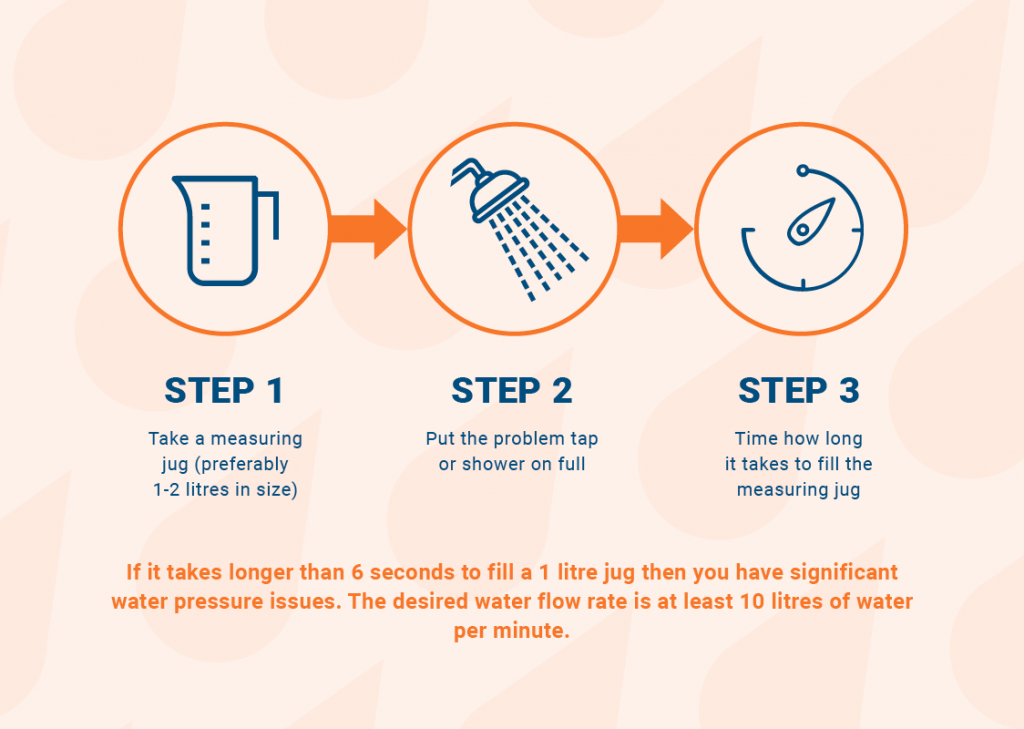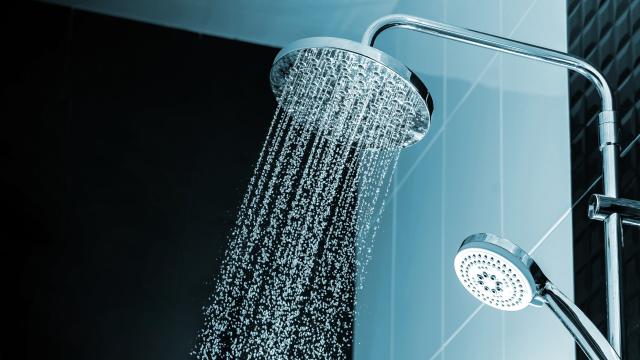The fact that we have running water in our homes is pretty miraculous, if you think about it. Unlike other points in history — and other parts of the world — many of us have the privilege of turning a few knobs and being showered in clean, hot water. But sometimes the pressure of that water isn’t ideal. This can be especially frustrating with a shower in your own home that you know is capable of greater things, but for some reason, is under-performing when it comes to pressure. If this is something you’re dealing with, here are a few things to try.
Test your water pressure

Sometimes you can easily tell if you’re dealing with low shower pressure, but other times you might want to do a quick check to confirm. In this case, all you’ll need is a measuring jug. Just follow the infographic above: and take your measuring jug (ideally one or two litres in size), turn the shower on full blast, and then time how long it takes to fill one litre of water in the jug.
If it takes longer than six seconds, you’re probably dealing with low water pressure, according to Anchor Pumps, a UK-based plumbing company. The low pressure could have a number of different causes, though. Here are a few simple ways to try and fix it yourself, without having to call a plumber.
Clean your shower head
We’re putting this first because sometimes the most simple solution is the one we overlook. It’s totally normal for shower heads to get clogged with mineral deposits and other gunk over time, so if you haven’t cleaned yours in a while (or ever), start with that.
Instead of investing in some single-use cleaner, just unscrew your shower head and let it soak in a bowl of vinegar for eight hours. Once it’s out, if you see any remaining mineral deposits, The Spruce recommends using a toothpick to press those out. If it’s still clogged, it’s probably time to invest in a new shower head.
Check your shower head and its settings
Another possible cause for low pressure is having a water-saving shower head. This may be the case if you’ve just moved into a new place and notice that the pressure is low right off the bat. If that’s the case, the previous tenant may have installed a water-saving shower head to reduce the flow and save water. Though better for the environment, it might not be getting all the suds out of your hair.
Some low-flow shower heads have a flow restrictor that allows you to adjust the water pressure. The solution to your problem may be to reset the flow restrictor. To try this, follow these instructions from the Home Guides vertical of SF Gate:
Use a pair of wide-mouth locking pliers or a pipe wrench and rag to take the showerhead apart. Many showerheads come equipped with a flow restrictor built into them to help homeowners avoid wasting water. The flow restrictor is typically a white plastic disk with a small hole in the middle of it. The water has to push through that small hole before it comes out the showerhead. By removing the flow restrictor, you can improve the shower flow.
Check the water main valve
If you’ve tried both of the potential solutions above and are still having issues, you may have to check your water main valve, which controls the amount of water the flows to each of the fixtures in the house. It may turn out to partially closed, which could definitely affect the water pressure in your shower. There are two primary valves you’re going to want to check, according to the experts at Terry’s Plumbing in Pittsburgh, PA:
Main valve: The water main to your house will be located near your water metre. You’ll see two valves; turn both of them counterclockwise to open them fully.
Shower valve: This will probably be located in your home’s basement, crawl space, or in an access panel behind the shower. Turn it counterclockwise to open it up.
If neither of those are partially closed, it may be an issue with your curbside water valve, so you’re going to need to contact your local municipality.
Call in a professional
At this point, you’re probably going to want to call a plumber if you haven’t been able to fix or track down the issue with the water pressure. They should be able to pinpoint and then solve the problem, getting you back into a shower with adequate water pressure in no time.
This story was originally published on March 1, 2013 and was updated on April 23, 2021 with more information to meet Lifehacker style guidelines.

Leave a Reply
You must be logged in to post a comment.